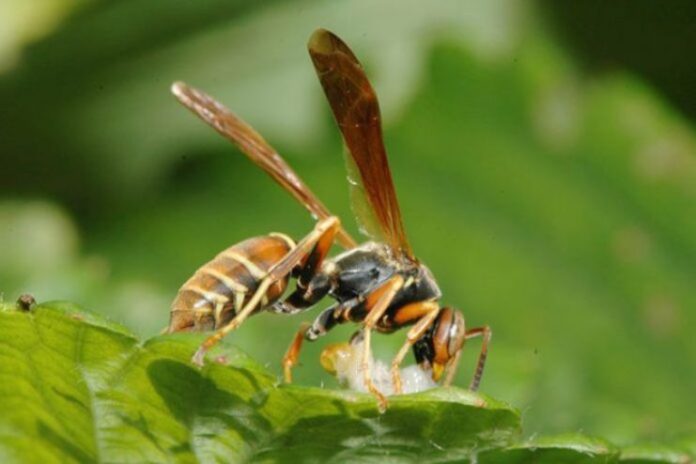Affiliate Disclaimer
Some links in this article are affiliate links. We may earn a small commission if you make a purchase through these links, at no extra cost to you. We only recommend products we find useful to our readersWho does not love to spend summer evenings in green yards around our homes and gardens?The yards, full of plants and flowers, help freshen our minds and lighten our moods. But little creatures such as flies and insects like wasps may ruin our evenings.
At times, insects like wasps may even build nests in and around our homes, which may turn bothersome. Read through to learn the best natural ways to get rid of wasps.
What Are Wasps? What Do They Look Like?
A wasp is an insect belonging to the Order Hymenoptera, distinct from bees and ants. Wasps come in a variety of colors, including yellow, brown, metallic blue, and bright red. Their appearance and size vary significantly depending on the species.
A wasp has a pinched waist and two pairs of wings. They get attracted to plant life, flowers, outdoor eating areas with spills, open garbage cans, gutters, and soffits. They prey on spiders and insects.
Are Wasps Harmful?
Wasps can make yard work challenging and disrupt outdoor activities. While they usually do not sting, they may become aggressive if disturbed or threatened. In most cases, wasp stings are harmless, but for individuals allergic to wasp venom, a sting can cause serious reactions.
Types of Wasps
Each wasp species comes with its unique characteristics. They are broadly classified as:
1. Yellowjacket Wasp (Vespula)
Yellowjacket wasps are known to be aggressive and will sting if threatened. They tend to defend their colonies. These wasps are attracted to perfume and colorful clothing.
2. Bald-faced Hornet (Dolichovespula Maculata)
Bald-faced hornets are aggressive and may sting repeatedly if provoked. They are omnivores, feeding on caterpillars, flies, and spiders. They squirt venom into the eyes of nest intruders, which may lead to temporary blindness.
3. Paper Wasp (Polistes Dominula)
They are comparatively less aggressive and feed on nectar, flies, caterpillars, and beetle larvae. Paper wasps prefer to build nests in sheltered, dark, shady places.
4. Mud Dauber Wasp (Chalybion, Sceliphron)
These wasps rarely sting and are beneficial in keeping spiders and other pests away. Mud daubers have good vision.
5. Ichneumon Wasp (Megarhyssa Macrurus)
These wasps control pest populations. They feed on shrubs, nectar, and trees. Most Ichneumon wasps do not sting humans.
Wasp stings can be painful and may cause life-threatening allergic reactions in some people. Hence, it is always better to deter wasps from your premises.
But the best part is that we do not have to use harsh sprays to eliminate wasps. Simple, natural ways can be employed to keep wasps away.
13 Home Remedies to Get Rid of Wasps
1. Natural Insecticide Sprays
Organic wasp insecticide sprays made of food-grade ingredients like peppermint oil help keep wasps away. Spray it in the areas where there are more wasps. The spray may smell pungent due to the essential oils but it is not harmful to humans.
Another homemade wasp repellent can be made with an essential oil blend of clove, lemongrass, and geranium essential oils.
How to Make:
- Mix several drops of each oil in a spray bottle containing water.
- Add some squirts of dish soap.
- Spray and coat areas outside the house where wasps build nests.
2. Wasp Repellent Plants
Some green plants serve in deterring wasps. Plants that are natural wasp deterrents are thyme citronella, spearmint, wormwood, and eucalyptus. Growing them in your yards can help you have wasp-free zones. Moreover, they add natural beauty to your garden.
3. Peppermint Oil
Peppermint oil works effectively in removing wasps, according to a study(R)published in the Journal of Pest Management Science in 2013. Make homemade wasp repellent by following these simple steps:
- Add a few drops of peppermint oil to a cotton pad
- Strategically place the pads around your home, like porch roofs, ledges, and crevices.
Alternatively,
- Mix one tablespoon of peppermint oil into one liter of water and one tablespoon of unscented shampoo in a spray bottle.
- Spray the solution around the areas that are frequent with wasps to wade them away.
Note: Target spots where you’ve discovered old nests in the past. However, some types of wasps keep building new nests at new locations.
4. Sugar Water Wasp Trap
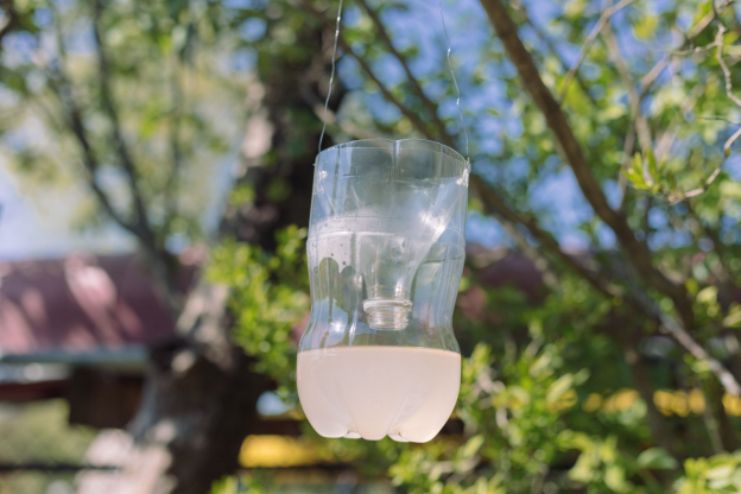
These traps attract wasps to fly in the container containing sweet sugar water and make them get into the trap. This solution can be made in a few minutes.
How to Make
- Cut the neck of the two-liter bottle
- Invert the neck inside the bottom of the bottle
- Tape using duct tape or packing tape
- Place the sugar and water mixture inside the bottle
- Hang the trap using a sting or fix using screws
- The wasps enter the bottle for sugar water but are unable to find a way to escape it and eventually get trapped
- Add cooking oil along the steep edges of the trap so the wasps can lose their footing and fall in
You may also use other liquids like soda bottles, vinegar, water, and laundry soap instead of sugar water.
Before emptying your trap, you must ensure all the wasps are dead by pouring boiled water inside the bottle. Or just throw the trap away in the trash. However, this would not help get rid of all the wasps as it may attract only the ones that pass by.
5. Vinegar Trap
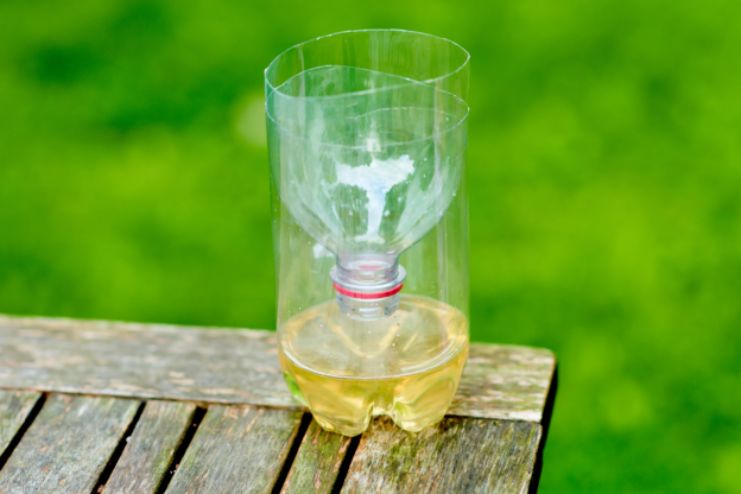
Using readily available, cheap, and natural ingredients like vinegar doesn’t just help get rid of bothersome wasps like insects, but is eco-friendly and less harmful to humans.
How to Make
- In a large bowl, mix 2 cups of sugar, 2 cups of apple cider vinegar, and 1 cup of water.
- Stir or whisk the mixture until the sugar fully dissolves. The sweetness will attract wasps.
- Gently stir in ½ cup of liquid dish soap without creating bubbles.
- The dish soap acts as a degreaser, breaking down the wasps’ protective coating and inhibiting their ability to fly, ultimately causing them to drown.
- Pour the prepared liquid into a 2-liter plastic soda bottle.
- Place the bottle on the ground in areas where wasps are frequently seen.
- Alternatively, tie a string around the bottle’s neck and hang it from a tree branch or fence post.
Prepare the Wasp Spray:
- Pour the remaining mixture into a 16-ounce spray bottle.
- Add 2 tbsp of liquid dish soap and ½ cup of water.
- Use this spray to target wasps directly when needed.
Also Read: What Happens When You Drink Apple Cider Vinegar In The Morning Every Day?
6. Tea Tree Oil Wasp Repellent
Tea tree oil is a popular natural way to repel bees and wasps. It works wonders as a natural agent that prevents wasps from stinging. Dab a bit of tea tree oil on yourself. It is helpful when you walk or are around any area with the possibility of wasps and bees.
7. Baby Powder
Surprisingly, baby powder is far better at keeping insects like wasps away than most chemicals and sprays. When you are walking in yards or gardens with the possibility of wasps, sprinkle baby powder on your face and other exposed body parts to keep bees and wasps away.
8. Cucumber Wasp Repellent
Many people use cucumbers in vegetable salads, but few know that they also serve as natural insect repellents. Instead of using harsh chemicals to keep bugs away, try natural ingredients like cucumbers near wasp nests.
Also Read: 13 Health Benefits Of Cucumber Water – Know Why Detox Is Important
9. Cayenne Pepper Wasp Repellent
Yet another natural ingredient, cayenne pepper, can be used to get wasps away from your surroundings.
How to use:
- Add water, three tablespoons of liquid cayenne pepper, and one tablespoon of dishwashing liquid into a one-liter spray bottle.
- Combine the mixture well and spray it on areas with wasps.
10. Spicy Spray Wasp Repellent
This is yet another cheap, home method to wade away wasps surrounding your home.
How to Make:
- Boil 3 cups water, add 2 chopped spicy chili peppers, and continue boiling for 2 minutes.
- Turn off the heat and allow the mixture to cool down.
- Strain in a spray bottle and try spraying the spicy solution at bees to repel them.
When using the spicy spray indoors, ensure proper protection and maintain a safe distance. The strong ingredients can be harmful if inhaled or come into contact with eyes and skin. Keep children and pets away during application.
How to Get Rid of Wasp Nests?
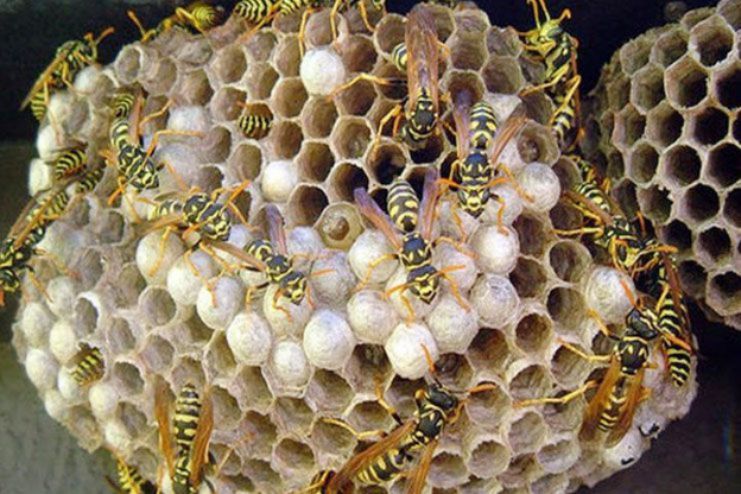
Now, let us check out some chemical-free ways to get rid of wasp nests. Firstly, it is important to note that removing wasp nests is dangerous and an experienced professional can do a better job.
While attempting, ensure to get an allergy test done for wasp stings and wear protective clothing. You should also have your escape route ready in case the wasps decide to swarm.
ImageSource: pinimg.com
11. Laundry Bleach for Wasps and Nests
Laundry bleach may be used as an insect repellent. Check below for the procedure for using it on wasps.
How To Use:
- Combine 2 parts water and 1 part bleach in a lawn sprayer that is long enough to spray at a 2-foot distance.
- Dress up with thoroughly protected clothing, including gloves, glasses, and a stocking cap.
- Soak the wasp nest with bleach water. Minutes later, check with a stick to see if all the wasps have fallen dead.
- Knock down the nest, leaving no room for the other wasps to enter again.
12. Soapy Water for Wasps
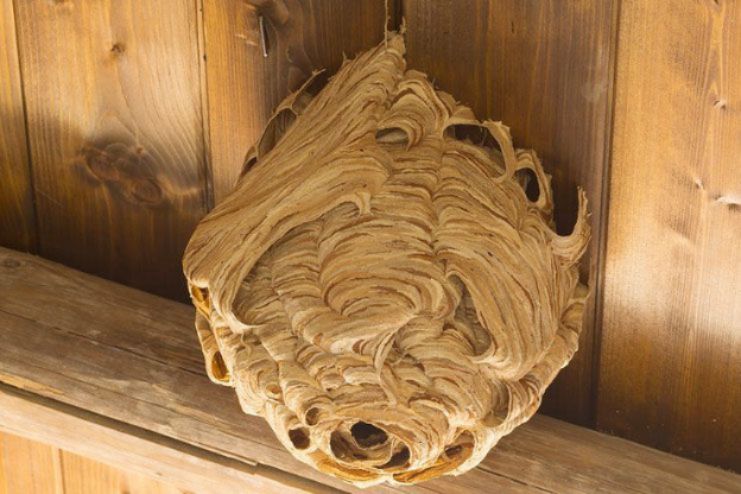
Using plain soap water is an eco-friendly way of removing wasps that have already been housed in your property.
How to Make:
- Fill a spray bottle with water and add two tablespoons of dish soap.
- Spray the solution directly onto hanging wasp nests.
- Soap may work to clog the breathing spores and the wasps may instantly die.
In case of large nests, you may use a garden hose by just attaching the hose-end sprayer and filling it with some dish soap solution.
Wear protective clothing and stand far away as this method may be a little messier. Allow the hose to run for some time, and then douse the nest with the soapy water. Wasps may not linger around but rather try to find a way to escape from perceived danger.
ImageSource: media.mnn.com
13. Smoke Them Out
This method of using smoke to remove wasp nests may also work as a protective measure to keep wasps away.
How to Make:
- Light a fire in a grill below the nest or build a fire underneath.
- As the smoke rises, it seeps into the nest.
- The wasps suffocate and evacuate.
- Let the smoke rise for an hour or two.
- When you are sure that the nest is empty, knock it down with a stick.
- Keep a spray bottle with soap and water handy to use in case of any live wasps.
However, this technique works best when wasp nests are hanging in the air from tree branches or other exposed areas, but not in areas near your home.
Preventive Measures to Drive Away Wasps
Prevent attracting wasps in your yard or home by following a few simple measures:
- Removing unwanted food.
- Cover trash cans.
- Keep cleaning pet food and bird food.
- Sweet things attract wasps, like perfumes and nectars.
- Get the repairs done to your home so that wasps do not find an opportunity to build nests.
- Fill rodent holes and burrows around the house or in the yard, as they may be perfect locations for nests.
- Buy or make natural and non-toxic wasp deterrents to place around the house and keep wasps away.
Conclusion
While wasps can be quite a nuisance, there’s no need to resort to chemicals. Fortunately, a treasure trove of natural remedies exists to keep these buzzing visitors at bay.
This article has explored effective solutions, from fragrant repellents like peppermint and clove oil to sweet traps that lure them in. For those who prefer a more aggressive approach, soapy water and spicy sprays can eliminate existing nests.
Remember, prevention is the best medicine. Keeping your home clean and tidy with tiny food debris and sealed garbage cans prevents wasps from setting up shop in the first place.
By embracing these natural methods and preventive measures, you can create a peaceful outdoor haven free from the worry of wasp stings. Now, enjoy those summer evenings in your beautiful green space!
-
Jan 2018Written by Sumana Maheswari
-
Feb 2025Edited by Lakshmi Gayatri
In this Article













